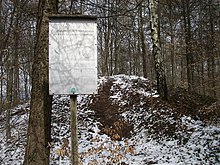Prince's grave mound Sonnenbühl
The prince grave mound Sonnenbühl is a Celtic prince grave from the 5th century BC. BC on the territory of the Swiss community Uitikon -Waldegg ( Canton Zurich ).
topography
The grave site is likely to have been connected to the oppidum Uetliberg (Fürstensitz) and is located on the Uetliberg around 500 meters from the SZU mountain station at an altitude of 795 m above sea level. M. on the eastern edge of the plateau between Aegerten and the SZU-Bahnstation Ringlikon.
history
The grave site was laid by Celts who settled in what is now Zurich during the La Tène period in the early 5th century BC. The archeology was made aware of the barrow in 1900 . The scientific investigation and reconstruction of the burial mound did not take place until the summer of 1979 at the instigation of the Foundation for the Exploration of the Uetliberg, financed by the Paul Schiller Foundation, under the direction of the Monument Preservation of the Canton of Zurich.
Archaeological evidence
Burial mound
At the time of the archaeological investigations in the summer of 1979, the burial mound was three meters high and 20 meters in diameter. The grave building, made entirely of clay, was sparsely but evenly covered with stones, which must have been distributed over the entire surface of the hill when it was built, and of which the larger ones had sunk down over the millennia as a result of gravity.
Burial chamber
The burial chamber , oriented centrally from southwest to northeast, measures 3.2 × 3.4 × 1 meters and is excavated from the ground moraine clay; the excavated clay was deposited in a wall-like manner around the pit within a radius of about 2.5 meters. The burial chamber was robbed soon after the burial , presumably before the final completion of the burial mound, as indicated by humus discoloration on the circular excavated landfill and on the level of the forest floor.
The looted grave pit only contained a few stones that had fallen from the rotten ceiling of the wooden burial chamber, sparse, burned bone fragments , charcoal crumbs, some atypical ceramic shards , two charred willow rods lying on the floor and an eight centimeter long, rusted iron nail. South of the burial chamber was a two-meter-long and one-meter-wide pile of stones on which were burnt human bones, mostly from the head of a femur , which are attributed to a woman.
Single finds
Despite the robbery were found within this small, interspersed with burnt Knochenkrumen Erdfleckens a belt chain stems members, the fragment of a very small Certosafibel (both bronze ) and a gold rosette and two meters west of the grave pit two very artfully crafted gold discs - brooches that as exhibits are open to the public in the Swiss National Museum in Zurich .
The dimensions of the grave pit are comparable to those of the princely graves of the end of the older and beginning of the younger Iron Age - the objects found, especially the disk brooches with their spring editors, show similarities with the similarly decorated gold finds from the princely graves of Kleinaspergle , Schwarzenbach , Weiskirchen, etc. a. From this the archaeologists conclude that the Sonnenbühl grave site dates from around 400 BC. "Fürstin" who died in the 4th century BC may have originally contained a rich grave inventory.
photos
Web links
- Website Fürstengrabhügel im Sonnenbühl ( memento from April 15, 2009 in the Internet Archive ) with photos of the finds, sketches and further information on the subject
- Website Early Celtic Prince's Grave Hill near Zurich ( Memento from August 8, 2013 in the Internet Archive )
- Website Uetliberg – Verein: Research into prehistory and early history
Individual evidence
- ↑ Celtic prince seat is a term from the scientific discussion about the social structure in the Celtic Hallstatt period .
- ↑ Aegerten is a plateau north of the Uto Kulm, which was originally used as pasture and arable land.
- ↑ a b c d The information is taken from the signs at the location of the prince's grave hill in Sonnenbühl.
Coordinates: 47 ° 21 ′ 15 " N , 8 ° 28 ′ 56" E ; CH1903: 678 846 / 245337





